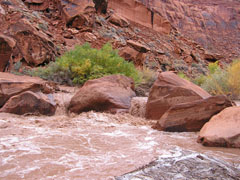|
|
|
|
Glen Canyon National Recreation Area
Environmental Factors
|
|
|
|
|
|
 |
 |
| NPS/John Spence | | Escalante River in flood |
 |
Environmental change is constant in the Colorado Plateau and Glen Canyon National Recreation Area (NRA). Changes can be the result of natural processes or human actions. Some can be easily observed during a visit while others may be so gradual that they are unnoticeable over the course of a lifetime. Long before humans came to the Colorado Plateau, environmental processes such as weather, geological processes, climate change, and fire regime shaped the region. The Colorado River and its tributaries carved out canyons, and plant and animal communities adapted to their environment or disappeared. More recently, humans increased their imprint on this environment through grazing, fire suppression, water development, and the introduction of nonnative species.
Livestock was brought into the Southwest in the 1500s by the Spanish. When railroads arrived in the late 1800s, large numbers of livestock were shipped to the area for grazing. By the 20th century, hundreds of thousands of cattle were grazing on the grassland and shrubland communities of the Colorado Plateau. Prior to the 1930s, overgrazing severely degraded the land, compacting newly barren soil and changing fire regimes by reducing or eliminating grassy fuel. The Taylor Grazing Act of 1934 helped restore many areas from previous damage by regulating grazing on federal public land. Riparian areas that supported diverse vegetation and wildlife were trampled, eroding banks and decreasing water quality. Today, ranchers of the Colorado Plateau maintain the ranching lifestyle their families developed over the last 150 years.
Fire regimes also changed with the settlement of Anglo-Americans to the area. Fires, which were typically frequent, low-intensity fires were perceived as a threat. By suppressing fires, large fuel loads accumulated and the fires that did burn were huge, high-intensity wildfires as is currently being seen in the West. The suppression of fire regimes changed nutrient cycles and decreased diversity. We are now seeing the effects of 100 years of fire suppression, and higher temperatures and reduced moisture availability associated with climate change.
|
 |
| NPS/John Spence | | Warm Fire in nearby Kaibab National Forest in 2006 |
 |
Fire regimes also changed with the settlement of Anglo-Americans to the area. Fires, which were typically frequent, low-intensity fires were perceived as a threat. By suppressing fires, large fuel loads accumulated and the fires that did burn were huge, high-intensity wildfires as is currently being seen in the West. The suppression of fire regimes changed nutrient cycles and decreased diversity. We are now seeing the effects of 100 years of fire suppression, and higher temperatures and reduced moisture availability associated with climate change.
As the West grew, populations demanded more water and energy. Dams were constructed on the Colorado River and other rivers of the West, controlling the flow of water. The construction of Glen Canyon Dam, which was completed in 1963 created Lake Powell, the nation’s second largest reservoir. Lake Powell flooded the canyons that had been carved out by the river over time, drowning archaeology sites, plants, and, animals, and irreversibly altering the environment. Construction of Glen Canyon Dam and other dams provided energy and water which supported agriculture and growing populations. The creation of Lake Powell created new recreation opportunities and increased visitation to the area, causing a greater human impact on the often fragile resources of the region. Water quality of Lake Powell and beaches are monitored in Glen Canyon NRA.
|
 |
| NPS | | Glen Canyon Dam |
 |
All of this human development brought nonnative species to this area and the rest of the country. Some nonnative species are successful at spreading and invading an area, disrupting its ecology by outcompeting native species, disrupting food chains, and changing nutrient cycles. These invasive exotic species in Glen Canyon NRA include nonnative plants like tamarisk (salt cedar, Tamarix chinensis), Russian olive (Elaeagnus angustifolia), ravennagrass (Saccharum ravennae), and cheatwgrass (Bromus tectorum). Invasive nonnative aquatic species include walleye (Stizostedion vitreum), fathead minnow (Pimephales promelas), New Zealand mudsnail (Potamopyrgus antipodarum), and water naiad (Naias marina). Eradicating invasive exotics is difficult, but can help native species reestablish themselves. Zebra mussels (Dreissena polymorpha), though not yet found in Lake Powell, are native to Eurasia, compete with native species, and clog pipes. They typically spread by vessels which have been in an infested body of water and have not been allowed to dry completely or decontaminated before entering another body of water. Zebra mussels are present in nearby Lake Mead, Lake Mohave, and Lake Havasu, a program is in place to prevent zebra mussels from spreading to Lake Powell.
Research conducted at Glen Canyon NRA provides insights on how some environmental factors change and affect the area. Continued research can be an important tool for understanding the role of change in an environment. Current research topics at Glen Canyon NRA include geology, soil, sound levels, archeological resources, frog and vegetation populations, and the affects of flows from Glen Canyon Dam on fish populations. Inventory and monitoring of plants and animals can reveal more about the resources of the area, and the natural processes and human actions which affect them. Consider your actions: how will they affect the environment you live in?
Published 8/07
|
|  |  |

|
 |
|
|






